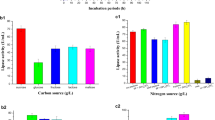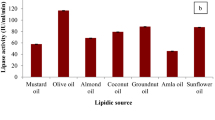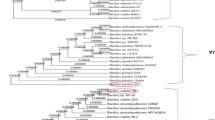Abstract
A bacterial isolate producing lipase, named S31, was isolated from soil and identified as a strain ofBurkholderia cepacia. S31 produced high activity of lipase which reached a maximum of 226.1 u/ml by fermenting at 30 °C for 60 h under the induction of olive oil. After purification, the lipase showed a single band of about 35 kDa in SDS-PAGE. The optimum temperature of the lipase was 70 °C and the optimum pH was 9.0. S31 lipase was stable at 40-70 °C and pH 0.5–10.0, as well as in several organic solvents, such as methanol, n-hexane, n-butanol, toluene and ethyl acetate. The presence of some metal ions (Ca2+, Mn2+, K+, Na+ and Mg2+) could activate the enzyme whereas Fe2+ and Cu2+ were found to be inhibitory. The lipase could cleave all of the three ester bonds of triglycerides. We conclude that S31 lipase is an alkaline lipase with a variety of highly desirable characteristics for research and industrial application.
Similar content being viewed by others
References
Bergey D.H. (1974). Bergey’s Manual of Determinative Bacteriology, 8th edn., Williams & Wilkins, Baltimore.
Boekema B.K.H.L., Beselin A., Breuer M., Hauer B., Koster M., Rosenau F., Jaeger K.E., Tommassen J. (2007). Hexadecane and Tween 80 stimulate lipase production inBurkholderia glumae by different mechanisms. Appl. Environ. Microbiol., 73: 3838–3844.
Cleasby A., Garman E., Egmon M.R., Batenburg M. (1992). Crystallization and preliminary X-ray study of a lipase fromPseudomonas glumae. J. Mol. Biol., 224: 281–282.
Coenye T., Vandamme P., Govan J.R.W., Lipuma J.J. (2001a). Taxonomy and identification of theBurkholderia cepacia complex. J. Clin. Microbiol., 39: 3427–3436.
Coenye T., Lipuma J.J., Henry D., Hoste B., Vandemeulebroecke K., Gillis M., Speert D.P., Vandamme P. (2001b).Burkholderia cepacia genomovar VI, a new member of theBurkholderia cepacia complex isolated from cystic fibrosis patients. Int. J. Syst. Evol. Microbiol., 51: 271–279.
Du W., Xu Y.Y., Zeng J., Liu D.H. (2004). Novozym 435-catalysed transesterification of crude soya bean oils for biodiesel production in a solvent-free medium. Biotechnol. Appl. Biochem., 40: 187–190.
Duenhaupt A., Lang S., Wagner F. (1992).Pseudomonas cepacia lipase: studies on aggregation, purification and on the cleavage of olive oil. Biotechnol. Lett., 14: 953–958.
Gao X.G., Cao S.G., Zhang K.C. (2000). Production, properties and application to nonaqueous enzymatic catalysis of lipase from newly isolatedPseudomonas strain. Enzyme Microbiol. Technol., 27: 74–82.
Gupta R., Gupta N., Rathi P. (2004). Bacterial lipases: an overview of production, purification and biochemical properties. Appl. Microbiol. Biotechnol., 64: 763–781.
Jaeger K.E., Eggert T. (2002). Lipases for biotechnology. Curr. Opin. Biotech., 13: 390–397.
Kordel M., Hofmann B., Schomburg D., Schmid R.D. (1991). Extracellular lipase ofPseudomonas sp. strain ATCC 21808: purification, characterization, crystallization, and preliminary X-ray diffraction data. J. Bacteriol., 173:4836–48411.
Lesuisse E., Schanck K., Colson C. (1993). Purification and preliminary characterization of the extracellular lipase ofBacillus subtilis 168, an extremely basic pH-tolerant enzyme. Eur. J. Biochem., 216: 155–160.
lizumi T., Nakamura K., Fukase T. (1990). Purification and characterization of a thermostable lipase from newly isolatedPseudomonas sp. KWI-56. Agric. Biol. Chem., 54: 1253–1258.
Mencher J.R., Alford J.A. (1967). Purification and characterization of the lipase ofPseudomonas fragi. J. Gen. Microbiol., 48: 317–328.
Ogino H., Nakagawa S., Shinya K., Muto T., Fujimura N., Yasudo M., Ishikawa H. (2000). Purification and characterization of organic solvent tolerant lipase from organic solvent tolerantPseudomonas aeruginosa LST-03. J. Biosci. Bioeng., 89: 451–457.
Rahman R.N.Z.R.A., Baharum S.N., Basri M., Salleh A.B. (2005). High-yield purification of an organic solvent-tolerant lipase fromPseudomonas sp. strain S5. Anal. Biochem., 341: 267–274.
Rathi P., Bradoo S., Saxena R.K., Gupta R. (2000). A hyperthermostable, alkaline lipase fromPseudomonas sp. with the property of thermal activation. Biotechnol. Lett., 22: 495–498.
Steen J, Kirsten W.S., Borge D. (1991). Cloning, sequence, and expression of a lipase gene fromPseudomonas cepacia: lipase production in heterologous hosts requires twoPseudomonas genes. J. Bacteriol., 173: 559–567.
Stuer W., Jaeger K.E., Winkler U.K. (1986). Purification of extracellular lipase fromPseudomonas aeruginosa. J. Bacteriol., 168: 1070–1074.
Sugihara A., Ueshima M., Shimada Y., Tsunasawa S., Tominaga Y. (1992). Purification and characterization of a novel thermostable lipase fromPseudomonas cepacia. J. Biochem., 112: 598–603.
Svendsen A., Borch K., Barfoed M., Nielsen T.B., Gormsen E., Patkar S.A. (1995). Biochemical properties of cloned lipases from thePseudomonas family. Biochim. Biophys. Acta, 1259: 9–17.
Vandamme P., Holmes B., Vancanneyt M., Coenye T., Hoste B., Coopman R., Revets H., Auwers S., Gillis M., Kersters K., Govan J.R.W. (1997). Occurrence of multiple genomovars ofBurkholderia cepacia in cystic fibrosis patients and proposal ofBurkholderia multivorans sp. nov. Int. J. Syst. Bacteriol., 47: 1188–1200.
Vandamme P., Holmes B., Coenye T., Goris J., Mahenthiralingam E., Lipuma J.J., Govan J.R.W. (2003).Burkholderia cenocepacia sp. nov. — a new twist to an old story. Res. Microbiol., 154: 91–96.
Yabuuchi E., Kosako Y., Oyaizu H., Yano I., Hotta H., Hashimoto Y., Ezaki T., Arakawa M. (1992). Proposal ofBurkholderia gen. nov. and transfer of seven species of the genusPseudomonas homology group II to the new genus, with the type speciesBurkholderia cepacia (Palleroni and Holmes 1981) comb. nov. Microbiol. Immunol., 36: 1251–1275.
Yan J.Y., Yang J.K., Li X., Yan Y.J. (2007). Gene cloning, overexpression and characterization of a novel organic solvent tolerant and thermostable lipase fromGalactomyces geotrichum Y05. J. Mol. Catal. B: Enzym., 49: 28–35.
Yang J.K., Guo D.Y., Yan Y.J. (2007). Cloning, expression and characterization of a novel thermal stable and short-chain alcohol tolerant lipase fromBurkholderia cepacia strain G63. J. Mol. Catal. B: Enzym., 45: 91–96.
Author information
Authors and Affiliations
Corresponding author
Rights and permissions
About this article
Cite this article
Lu, Y., Lu, F., Wang, X. et al. Identification of bacteria producing a thermophilic lipase with positional non-specificity and characterization of the lipase. Ann. Microbiol. 59, 565–571 (2009). https://doi.org/10.1007/BF03175147
Received:
Accepted:
Issue Date:
DOI: https://doi.org/10.1007/BF03175147




